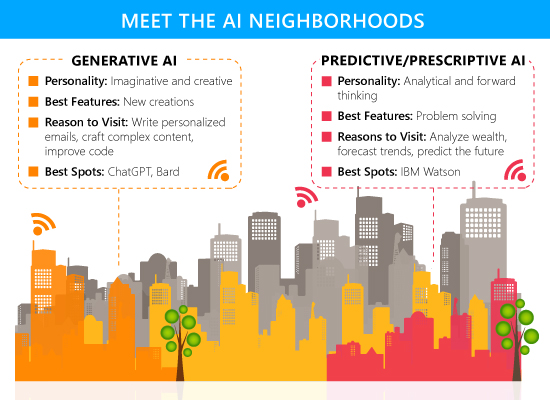If Artificial Intelligence (AI) were a bustling city, Generative AI and Predictive/Prescriptive AI would be two of its most vibrant neighborhoods.
Each has its unique charm, and yet they both pulsate with the same life force—data. As we delve deeper into these neighborhoods, we’ll discover how the residents, various types of AI tools, can significantly enhance the effectiveness of fundraising departments within nonprofit organizations.
Despite the cutting-edge advancements in our AI city, we cannot overlook the central role of human inhabitants—the subject matter experts. Their intuitive knowledge, honed through years of experience, acts as the city’s guides, providing context and perspective to the AI tools. These experts are the architects of the city’s skyline, interpreting the raw data and giving it meaning. They offer a depth of understanding that AI, at this stage, cannot fully replicate. The future we envision is not a city run solely by AI, but rather a collaborative space where humans and AI work in tandem, each leveraging their unique strengths to drive efficiency and effectiveness in fundraising.
Additionally, we must consider thoughtful application of AI in fundraising. It’s not feasible to merely turn on the AI switch and anticipate flawless results. Instead, we must comprehend the speed of business and the intended outcome, engage critical thinking, and deploy the appropriate tool. While our strategy to fundraising may evolve with the integration of AI, the essence of fundraising remains unchanged: It’s about connecting people to causes and building enduring relationships.
Unveiling the AI Neighborhoods: Generative and Predictive/Prescriptive AI
- Generative AI. First, we step into the world of Generative AI, often considered the more imaginative and creative neighborhood in our AI city. This neighborhood’s residents are akin to artists with a knack for creating something entirely new from a palette of different influences, incorporating captivating images, enchanting pieces of music, and even lines of code. One of its notable inhabitants, GPT-4, a model developed by OpenAI, is using its generative skills to write incredibly diverse and complex pieces of content, from personalized emails to comprehensive reports, all tailor-made to meet the unique needs of different organizations.
- Predictive/Prescriptive AI. In the next neighborhood over, we find the realm of Predictive/Prescriptive AI. This neighborhood has a distinctly analytical and forward-thinking vibe. Its residents are like a team of expert detectives who use past data (or “clues”) to predict future happenings. In a nonprofit setting, Predictive AI could forecast future donor behaviors or identify the next big philanthropic trend. One of its key residents, Watson, a model developed by IBM, is using its prescriptive skills to formulate strategic actions based on these predictions. Watson’s ability to analyze a wealth of data and suggest actions makes it an invaluable advisor, guiding organizations on the best course of action to achieve their objectives.
Using Their Unique Powers: The Contrasts
Each of these AI neighborhoods leverages its unique capabilities to serve nonprofit organizations. Generative AI, with its creative spirit, pushes the boundaries of innovation. It can craft compelling narratives that inspire potential donors, creating content that deeply resonates with your target audience and promotes your organization’s mission.
Predictive/Prescriptive AI, meanwhile, wields its powers of analysis and foresight to optimize fundraising strategies. It can help nonprofits make truly data-informed decisions by predicting how well a campaign will perform and then advising on how to boost donor engagement even more.
Predictive and Prescriptive AI: Data Governance and Efficient Data Ecosystems
What powers the Predictive/Prescriptive AI neighborhoods is data. But it’s not just about having data, it’s about managing it well and using it efficiently. That’s where data governance and efficient data ecosystems come into play.
Data governance is like the city council of our AI city. It ensures that the data used by AI is accurate, available when needed, and securely stored. It’s about having the right rules and systems in place to manage data effectively. Without proper data governance, our AI neighborhoods could make misinformed decisions or create irrelevant content.
An efficient data ecosystem, on the other hand, is like the city’s infrastructure—the roads, bridges, and pipelines that ensure everything flows smoothly. It involves everything from collecting and storing data to processing and analyzing it. It makes sure that AI models can access the right data at the right time, improving its accuracy and effectiveness.
The Future of AI in Nonprofit Fundraising: Risks and Challenges
Looking forward, the potential of AI for nonprofits seems limitless. However, like any bustling city, our AI city faces some challenges.
One major issue is data privacy. With AI relying heavily on donor data, ensuring this data is used ethically and securely is of utmost importance. We also must be vigilant about potential bias within AI. AI learns from the data it’s fed, and if that data contains biases, the AI could make biased decisions or produce biased content. It’s crucial that we work towards making our AI systems as fair and unbiased as possible.
Moreover, we must address the inherent challenges posed by the speed of business, particularly with respect to the velocity at which data changes. Different types of data have different velocities. For example, data regarding donor demographics might change relatively slowly, while data on donor engagement on social media might change much more rapidly. This affects how we need to think about the benefits of AI and the outcomes generated.
There are only two possible scenarios when outcomes can change: 1, the data changes or 2, the context changes. Because outcomes move at a similar speed of data, AI does not further our insight in a slowly changing and evolving landscape. Recognizing and adapting to these different speeds is crucial for effective and thoughtful AI application.
Another challenge is the digital divide. Not all nonprofit organizations have equal access to AI technologies, which could widen the gap between larger, tech-savvy organizations and smaller ones. It’s important to work towards making AI technologies more accessible and affordable so that all nonprofits can benefit from them.
In Summary
The world of AI is a complex and exciting city, home to the vibrant neighborhoods of Generative AI and Predictive/Prescriptive AI. These AI systems, powered by efficient data ecosystems and effective data governance, are revolutionizing fundraising, enhancing donor relations, and paving the way for a future filled with innovation and insight.
As we continue to explore and integrate these technologies into our organizations, we must also address the challenges that come with it. Ensuring data privacy, minimizing AI bias, and bridging the digital divide are crucial steps towards creating an equitable, efficient, and ethical AI-powered future for nonprofit fundraising.
With sleeves already rolled up, the work continues. The power of AI in fundraising is being harnessed further, accelerating the progress of our organizations and the causes we hold dear. After all, in the bustling AI city, opportunities abound for growth, innovation, and substantial impact. Looking ahead and to ensure fundraising’s future is hopeful, good “citizens” are needed to harness the power of AI and use it for good, and quickly. Embracing the potential of our AI neighborhoods and a brighter, more data-driven future for nonprofits is taking shape.
At BWF, we stand ready to assist you with all your fundraising AI needs. Please reach out to Senior Vice President, Decision Science Alex Oftelie at aoftelie@bwf.com or Reed Tyler, Associate Managing Vice President, Business Intelligence, at rtyler@bwf.com. It’s a privilege to help.





